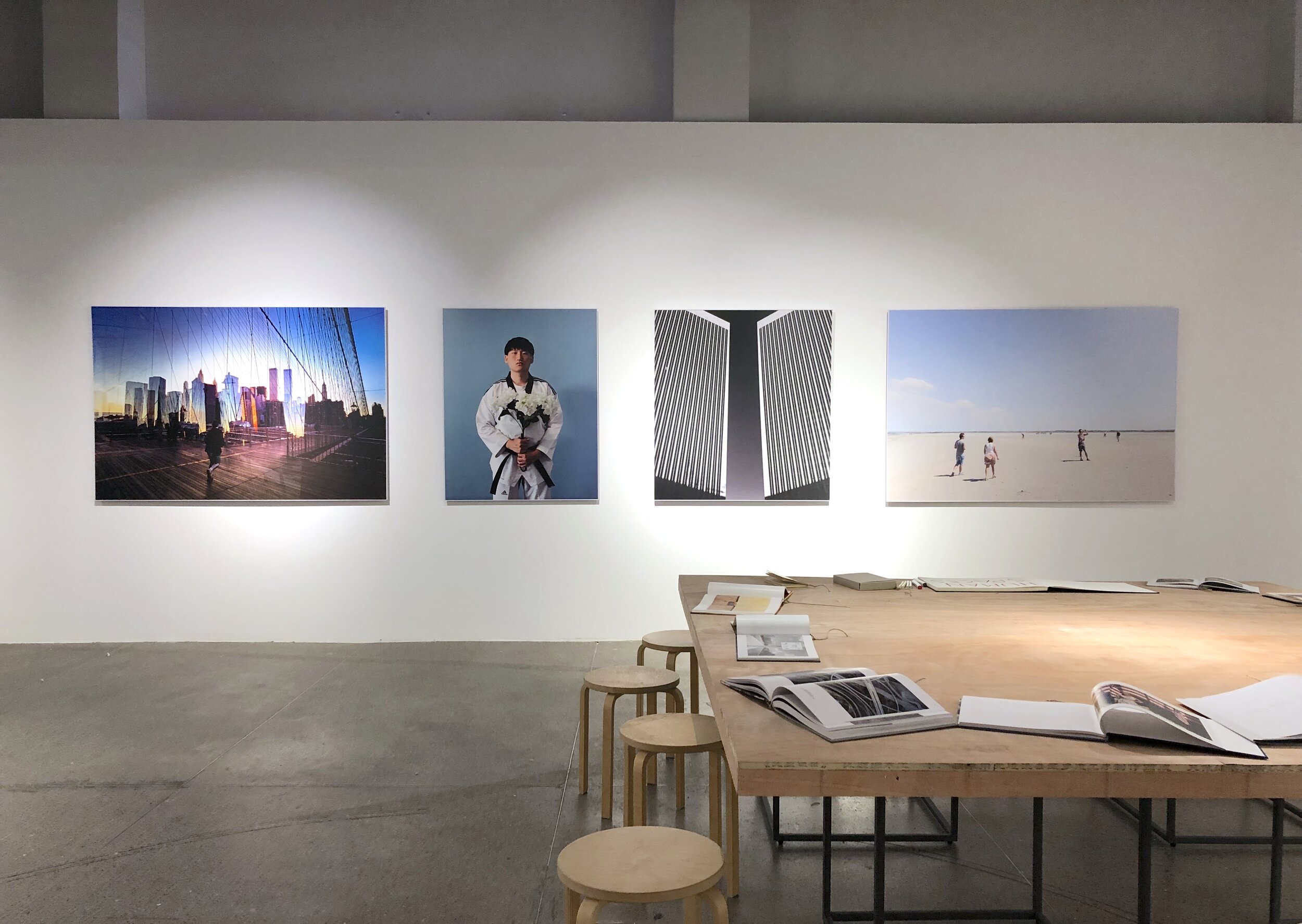北宁公园 / BeiNing Park
B座 / Pavilion B
2楼/2 Floor
策展人/ Curator
爱丽丝•可兰托尼
Alice Colantuoni
本次展览从建筑研究和人类学视角 ,到社会报告文学和街头摄影,通过摄影媒介探索人与空间的关系。邀请了来自中国、美国和意大利的四位艺术家向您呈现有关拍摄地、居民和摄影风格之间的对话。
人居环境关注人与人,与此同时也关注人与其他生物。一边是国家, 另一边是城市, 二者是有机的一体。 一个生态系统 (人与其他物种之间) 和一个社会系统 (人与同类之间) 都要遵循均衡的法则。如果一种均衡被打乱, 生态系统就会发生变化, 有时候甚至会自我毁灭, 而处于不平衡状态的社会系统也是如此。
—Yona Friedman.如何居住在这片土地上,1976
什么将空间视为具有人性的?什么样的空间更受人类存在的迹象影响?城市是一个有利于人与人之间互动的空间,这种互动可能性比在乡村更大。如果想象一个没有人居住的城市,我们会看到一个促进轻松和频繁人际关系构想的结构。在城市之外,人们沉浸在更广阔的环境中;从视觉上看,人类存在的迹象很少,与他人的交流很少,通常发生在火车和汽车的高速运动中。互联网,社交媒体等新的“云”技术如何影响人类通过空间相互联系的方式?即使在互联网和虚拟现实时代,门仍然可以连接并分隔房间、窗户并与建筑物和外界相连,地铁连接社区,公共场所聚集着具有共同叙事的人——建筑结构影响着人们的生活。正如弗里德曼在开场白中所言,建筑物和基础设施可以减少或促进人与人之间联系的可能性,并承担着平衡的生活环境的责任。
不同的摄影项目如何质疑现代人类住区中的平衡观念?摄影时如何讲述人们“聚群”,组织和情感上关联了人物私人与集体之间的生活空间?摄影将结构、形式和人物组织成视觉上连贯的叙述。在人类空间展出的项目叙述了在城市和乡村环境中个人,社区及其居住空间之间的多重联系。在展出的作品(人像,街道场景,风景)中,即使人们不在画框内,空间展示着人类活动。
费拉拉(Ferrara)的“低潮”(Lide Tide)系列中的视觉氛围非常稀少,并减少了一些基本元素:表面,运动中的某些人物。人类散布在一个空旷的空间中,从远处可以看到自然景观,将自己布置成千变万化的自发星座。
Chen的《冰冻土地》探索了中国东北地区日渐缩小的城市,这是一个冰冷的环境,人们很少有机会在街上见面,摄影师本人也必须使用app才能与当地人建立联系。在这片荒凉的风景中,室内和景观显然与人的情感共鸣。
在展览的过程中,出现了一系列建筑,Rasulo认为这是不同美感和/或功能性观念的独特表达,反映了不同的文化特征。在他们中间,一张照片突然打开了亲密的空间。
赫尔曼(Herman)在纽约和那不勒斯之间拍摄的街拍照片最终更紧密地捕捉了人类。人们开心,人们工作,无所事事,思考,等待,期待。无论身体还是在情感上人们共同居住在城市空间之中,人类的这些瞥见被叠加并融合到城市景观中,形成了惊人的诗意并置。
在一起看,这些照片是比现实更清晰的视野。它们是思考的一种方式。正如赫尔曼本人所说:“摄影向你展示了您的思维清晰程度。这是你进程中的外部化»。我们希望形容词“你”指的是我们所有人,是人类社区中空间的共同居民。当我们拍摄这些照片时,是我们自我审视的过程。
An architectural study, an anthropological visual essay, a street photography experience and a social reportage use the photographic medium to explore the relationship between human communities and their living space. A dialogue between places, inhabitants, and photographic styles including four artists from China, Europe, and the USA.
Human settlement concerns at the same time man among other organisms and man among other people. One is the country, the other is the city. […] An ecosystem (man among other species) and a social system (man among his peers) are both submitted to the laws of equilibrium. If an equilibrium gets disrupted, ecosystems transform, even sometimes destroy themselves, and social systems getting in disequilibrium do the same. —Yona Friedman. Comment habiter la terre / How to Settle on Earth, 1976.
What defines space as human? What kind of space is more affected by the signs of human presence? Cities are spaces favoring interaction between humans, where it is more likely than in rural spaces. If we imagined a city without people, we would see a structure conceived to foster the ease and frequency of human relations. Outside the city, people are immersed in a wider environment; visually, their presence is rarefied, and contact with other people is less frequent, often occurring in high-speed movements, on trains and cars. How do new ‘cloud’ technologies —Internet, social media— impact the way humans connect through space?Even in the Internet and Virtual Reality era, doors still connect and separate rooms, windows interface buildings and the outside, subway trains link neighborhoods, and public spaces gather people who share common narratives—architectural structures impact human life. As Friedman states in the opening quote, buildings and infrastructures diminish or facilitate the possibility of humans connecting, and are responsible for a balanced living environment.
How do different photographic projects question the idea of equilibrium in modern human settlement? How do they describe the way people ‘pack’, organize and emotionally relate to their private and collective living space? Photography organises structures, forms, people into visually coherent narrations. The projects exhibited in Human Spaces narrate the multiple connections between individuals, communities and their living space, both in urban and rural environments. In the works exhibited, —portraits, street scenes, landscapes— space remains human even when people are not in the frame.
The visual atmosphere in Ferrara’s Low Tide series is rarefied and reduced to a few essential elements: a surface, some figures in movement. Humans are scattered across an empty space, a natural landscape seen from a distance, arranging themselves into ever-changing, spontaneous constellations.
Chen’s Freezing Land explores the shrinking cities of northeastern China, a freezing environment where people have few chances to meet in the street and the photographer himself had to use an app in order to connect with the locals. In this desolate scenery, interiors and landscapes clearly resonate with human emotion.
Progressing through the exhibition, a series of buildings appear, which are seen by Rasulo as unique expressions of different ideas of beauty and/or functionality, reflecting a diversity of cultural identities. In the middle of them, a single portrait suddenly opens a space of intimacy.
Herman’s street photographs, shot between New York and Naples, finally capture humans more closely. People having fun, people working, doing nothing, thinking, waiting, looking. People who live according to the physical and emotional space available to them as co-inhabitants of urban spaces. These glimpses of humanity are superimposed on and merge into urban landscapes, creating astonishing poetic juxtapositions.
Perceived together, these photographs are a vision clearer than reality. They are a means of thinking. As Herman himself has stated: «Photography shows you how clearly or not you’re thinking. It’s an externalization of your progress». We would like the adjective yours to refer to all of us, co-inhabitants of spaces within the human community. As we take in these pictures, it is our own progress we begin to question.


